Art. Architecture. City. These are, wanting to summarize the work of Francesco Somaini (Lomazzo, 1926 - Como, 2005), the three pillars of the great mental scaffolding on which the sculptor built his multifaceted vision. Dedicated to this multifacetedness is the project Somaini and Milan created by Luisa Somaini, the sculptor’s daughter, with a roster of first-rate curators: Francesco Tedeschi, Danka Giacon and Fulvio Irace, and with the support of Crédit Agricole and Esselunga. The project finally sees the light of day after a very long period of incubation that can be traced back to 2010, the year the Fondazione Somaini was founded, when on the occasion of a small exhibition at the Milan Triennale dedicated to the sculptor’s American season, Luisa Somaini and Enrico Crispolti began to entertain theidea of conceiving a large monographic exhibition in different Milanese institutions in order to deepen the bond that he weaved with the city of Milan, an absolutely indispensable factor for understanding his figure and important artistic transformations.
Thus was born Somaini and Milan, a corollary of three simultaneous exhibitions, set up at the Palazzo Reale, the Museo del Novecento and the Foundation in Corso di Porta Vigentina, which delves into all facets of the sculptor’s intense exchanges with the Lombard capital. And that’s not all, because Milan constitutes the starting point of an ideal itinerary that visitors are invited to follow in the footsteps of Somaini’s work, a treasure that counts not only works of art but also a plurality of references, interventions, projects and connections scattered throughout Italy and abroad, precious supports for the rediscovery of one of the most versatile and accomplished figures in the art of the second half of the 20th century.
Originally from Lomazzo, in the province of Como, where he was born in 1926, Somaini studied at the Brera Academy in Milan, where between 1945 and 1947 he was a student of Giacomo Manzù. From then on, Milan would become his city of choice, the setting for numerous projects in the years to come and the scene of the blossoming of ties and relationships with cultural circles that helped shape his ideas in new directions. One above all was the MAC/Espace he joined in 1955, a broad art movement founded in Milan by Gillo Dorfles, Bruno Munari, Ettore Sottsass and others, which later merged with the Groupe Espace led by André Bloc in France. MAC, which aspired to promote non-figurative art in the wake of the Concretism theorized by Van Doesburg and Kandinsky in the 1920s, drew to itself not only painters and sculptors, but also graphic designers, industrial designers and architects who made significant contributions to the great postwar debate on the synthesis of the arts. Decisive was Somaini’s friendship with Enrico Crispolti and even more so with Luigi Caccia Dominioni, with whom he collaborated closely for twenty years. Stimulated by the ongoing cultic climate Somaini would identify in architecture the necessary prerequisites to expand his artistic research, arriving at the design of an increasingly monumental sculpture, in deep symbiosis with the urban field, the city and the territory. This process has its apex in the publication of the volume Urgency in the City signed with Enrico Crispolti in 1972, which collects the theories derived from the numerous design studies in which sculpture is configured as an art devoted to requalifying the urban fabric, transforming the neighboring environment or, in some cases, serves as a social critique towards the territory in which it is inserted, as happens in the Progetti Polemici and the metropolitan photomontages.
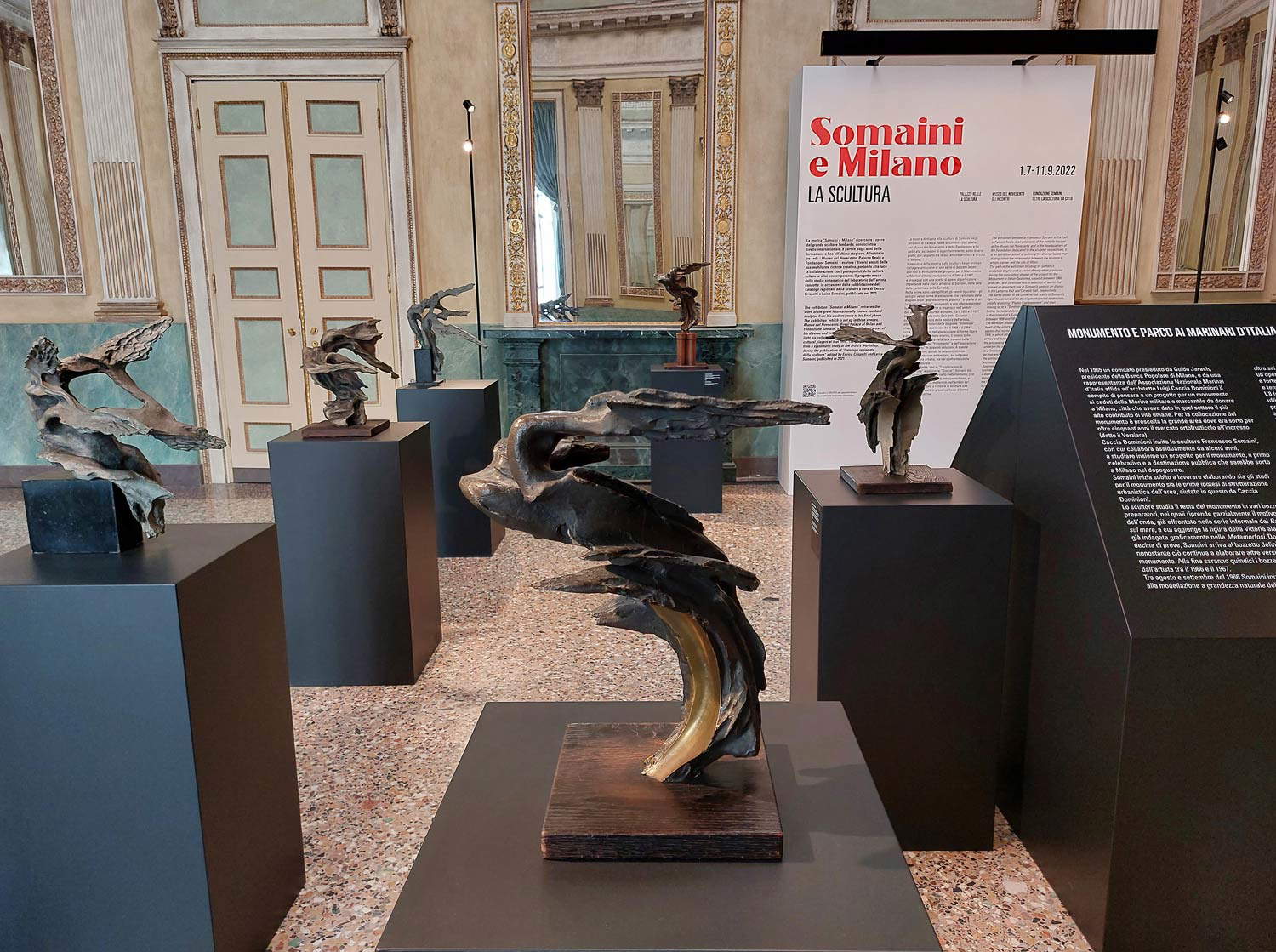

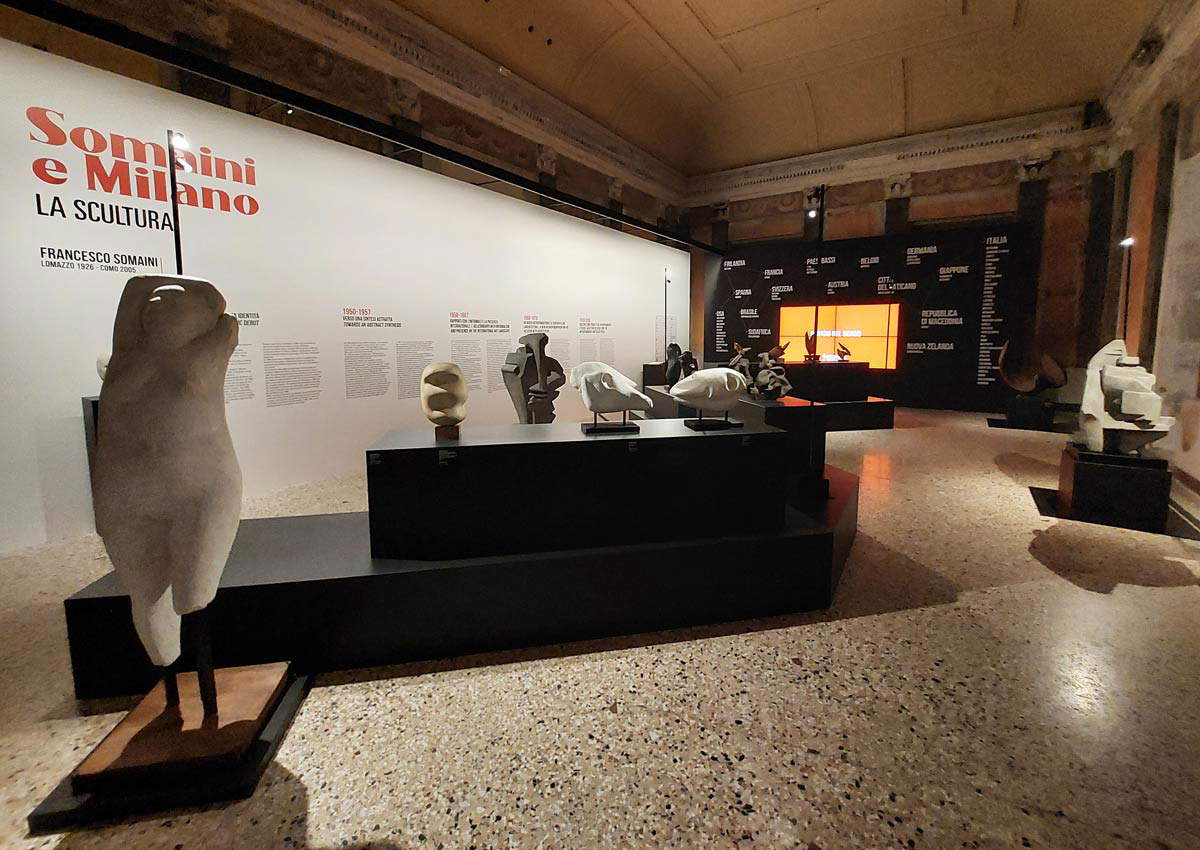


The first stop can only be Palazzo Reale, with the exhibition Somaini and Milan. Sculpture since, as curator Francesco Tedeschi recalled, “Somaini is not reducible to his specifically sculptural activity, yet he is first and foremost a sculptor.” Exhibition, by the way, wisely anticipated by the presence of the work Development of an Anthropomorphic Work (1979) installed in Piazzetta Reale, whose rosy and softly curled surfaces not only kindle clear references to Somaini’s sculptural qualities, but also cite that eroticism often concealed in his abstract anthropomorphic forms as well as the relationship between work and urban space: all key concepts that we will find in the other exhibitions of the cycle and that make the work a perfect landmark of the initiative.
At Palazzo Reale the theme is that of ’art in its purest essence, which in Somainian terms is sculpture. The seventy works, unfolded in three adjoining rooms of the Palace, are dated between 1948 and 1992 and thus document the different seasons of Somaini’s poetics by fixing its absolute cornerstones: the continuous search for innovation, the play of volumes and spaces, the relationship between full and empty, form and matter, work and environment. The Sala della Lanterna houses a small nucleus of sculptures that prelude the heart of the exhibition: it is the series of 15 preparatory sketches for the Monumenti ai Marinai d’Italia in Milan, which Somaini made between 1966 and 1967 at the invitation of architect Luigi Caccia Dominioni, in which the sculptor combines the wave motif with the classical iconography of Winged Victory. To create the final monument, more than 20 feet tall, Somaini experimented for the first time with the technique of casting sand at high pressure (which he had dubbed “God’s chisel”), fine-tuned to give greater vibration to surfaces and more tension between solids and voids, an utterly original technique that would form the basis of his creative process for modeling monumental sculptures.
In the next room, known as the Small Skylight Room, a small series of sculptures arranged in chronological order in a span from 1948 to 1957 accompany the visitor through the evolution of the sculptor’s style. The plaster works of the early days (the Bagnante [Stage II] of 1948-1949, presented at the Venice Biennale in 1950 and paying tribute to the magisterium of Marini and Manzù, opens the way) give way to works characterized by an increasingly abstract style dominated by curves and sinuous forms, which draw strength from the use of new, shiny materials such as bronze, lead, brass and pewter. The gaze eventually strands in the interstices of the sculptural surface of the mid-1950s: Struggle with the Monster (1950), Struggle with the Angel (1951), Great Warrior (1953) and Great Prisoner (1953) are transitional works that tell of Somaini’s attempt to measure himself against the Cubist experience, learned from Archipenko, Brancusi, Arp and other authors he met during trips to Paris in those years. And it is precisely these works that anticipate Somaini’s informal period that will characterize the sculptures he made from the 1950s to the 1970s.
![Francesco Somaini, Primavera d'altoforno I [I variante], 1963, Coll. privata
Francesco Somaini, Primavera d'altoforno I [I variante], 1963, Coll. privata](https://cdn.finestresullarte.info/rivista/immagini/2022/2016/francesco-somaini-primavera-d-altoforno.jpg
)

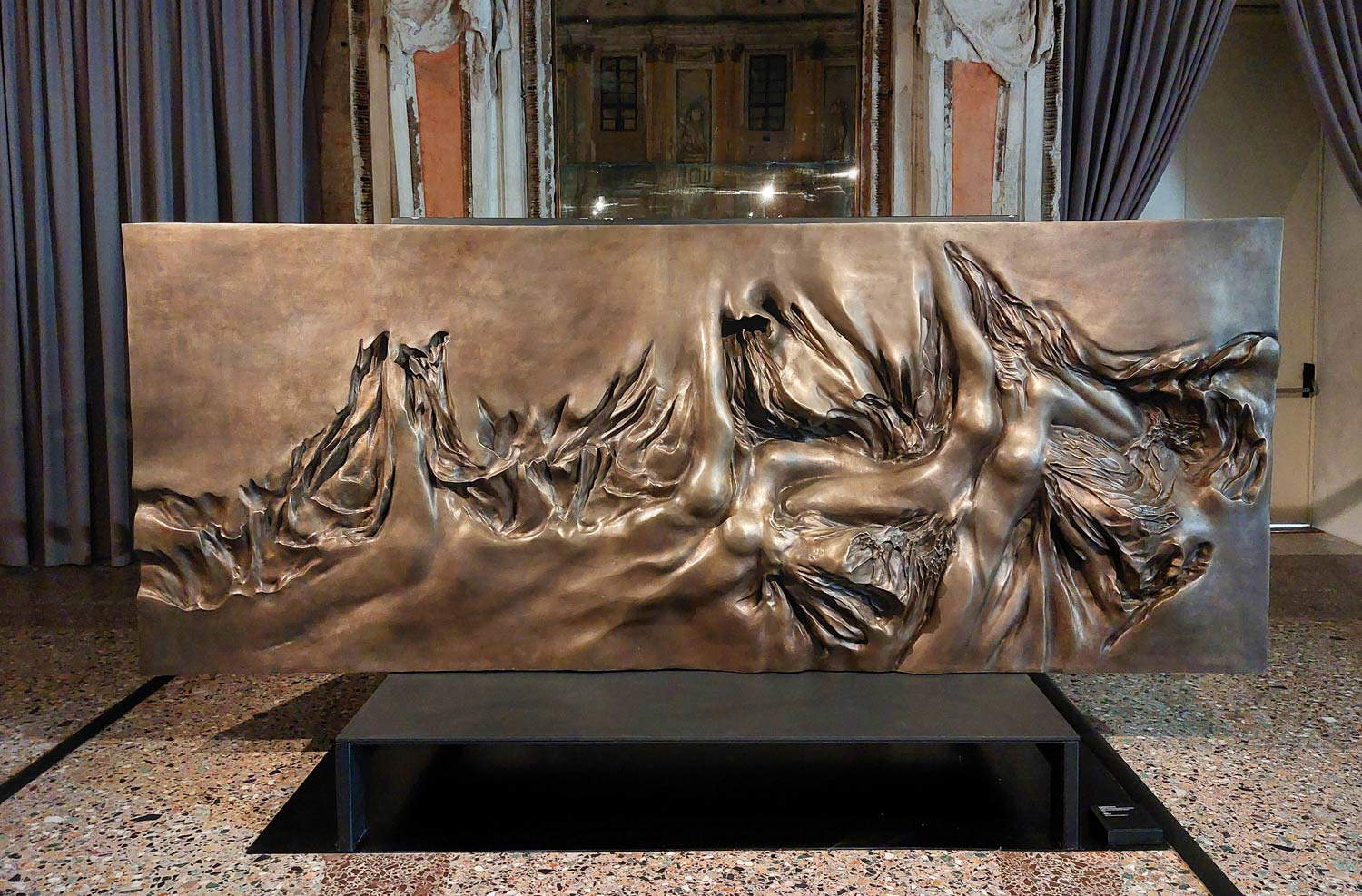


The choice to place the latter group in the Sala delle Cariatidi, a glorious setting steeped in historical connotations, is not accidental. The challenge was to create a common ground for dialogue and comparison on architecture, between Francesco Somaini’s more mature sculptures, already strongly oriented to the relationship between the work and its context, and the eighteenth-century aesthetics of the Sala, which for its part evokes all the splendor of Milan’s great architectural tradition through the centuries, beginning with the Caryatids motif that is repeated in the Omenoni of Palazzo Leoni-Calchi and in the frescoes of Palazzo Marino. Francesco Somaini loved to colloquy with the ancient and did so often, evidence of which is, for example, his interpretation of myth, from Prometheus Enchanted (1953) to the Great Trace for the Birth of Venus (1986) to the rhythmic reflection on the concept of metamorphosis that pervades his entire production.
In the Sala delle Cariatidi, the pivot of the entire exhibition, the triumph of matter in space, which is double, dominates. On the one hand, the work’s own space, which breaks free into forms almost elusive to the eye, irregular and jagged in piercing outlines(Great Wounded I, 1960; Great Proposal for a Monument III, 1961; Great Pathetic Tale, 1964), distorts and contorts(Great Anthropomonite I, 1975-77; First Anamorphic Matrix for Birth of Venus III, 1985; Fortunia I and III, 1988/1992), or it acts on itself (or against itself), imprinting in its own muscular matter traces and grooves that like tracks lead the thought to visualize the presence-absence of anthropomorphic entities already mutated into something else and converged elsewhere(Great Trace for Birth of Venus I, 1985; Coin and its positive and negative trace in human history, 1980-81, Antropoammonite XVI and Great Vertical Trace, 1977-78). But the space is also the surrounding space, invested by the physical and symbolic weight of the sculptures and thus restoring the full meaning of an art that has no way of being if not related to the external world, in function of which it can finally be activated. The procreative act of the ’archiscultore reaches its climax with the Carnificazioni di un’architettura, works caught in the midst of the metamorphic process that Somaini concretizes by inserting into the architectural elements alien segments that melt, distort, flex and screw, as if overcome by invisible forces and weights, creating fascinating contrasts between the rigid iron ends and the central bodies mutated into living, dynamic and suffering organic matter.
Already in these works, therefore, one can sense Somaini’s drive for architecture, which is fulfilled at the Museo del Novecento and finally at the Foundation. In the Archives Hall of the Arengario, the exhibition Somaini and Milan. Incontri curated by Danka Giacon delves into the relationships cultivated by the sculptor with architects Luigi Caccia Dominioni and Ico Parisi, united in a fellowship around which gravitated other key figures such as artist Lucio Fontana, writer Giorgio Bassani and photographers Ugo Mulas, Giorgio Casali and Enrico Cattaneo. In the extensive collection of materials on display are photographs, drawings, sketches and two architectural models: these are the models of the “Spazio R” project submitted to the competition (and unfortunately destined not to be chosen) for the Monument to the Resistance in Cuneo, on which the sculptor worked in 1962-1963 together with Lucio Fontana, Ico Parisi and Enrico Cavadini. An entire section is then devoted to projects for the paving of private and public Milanese properties made in collaboration with Luigi Caccia Dominioni.

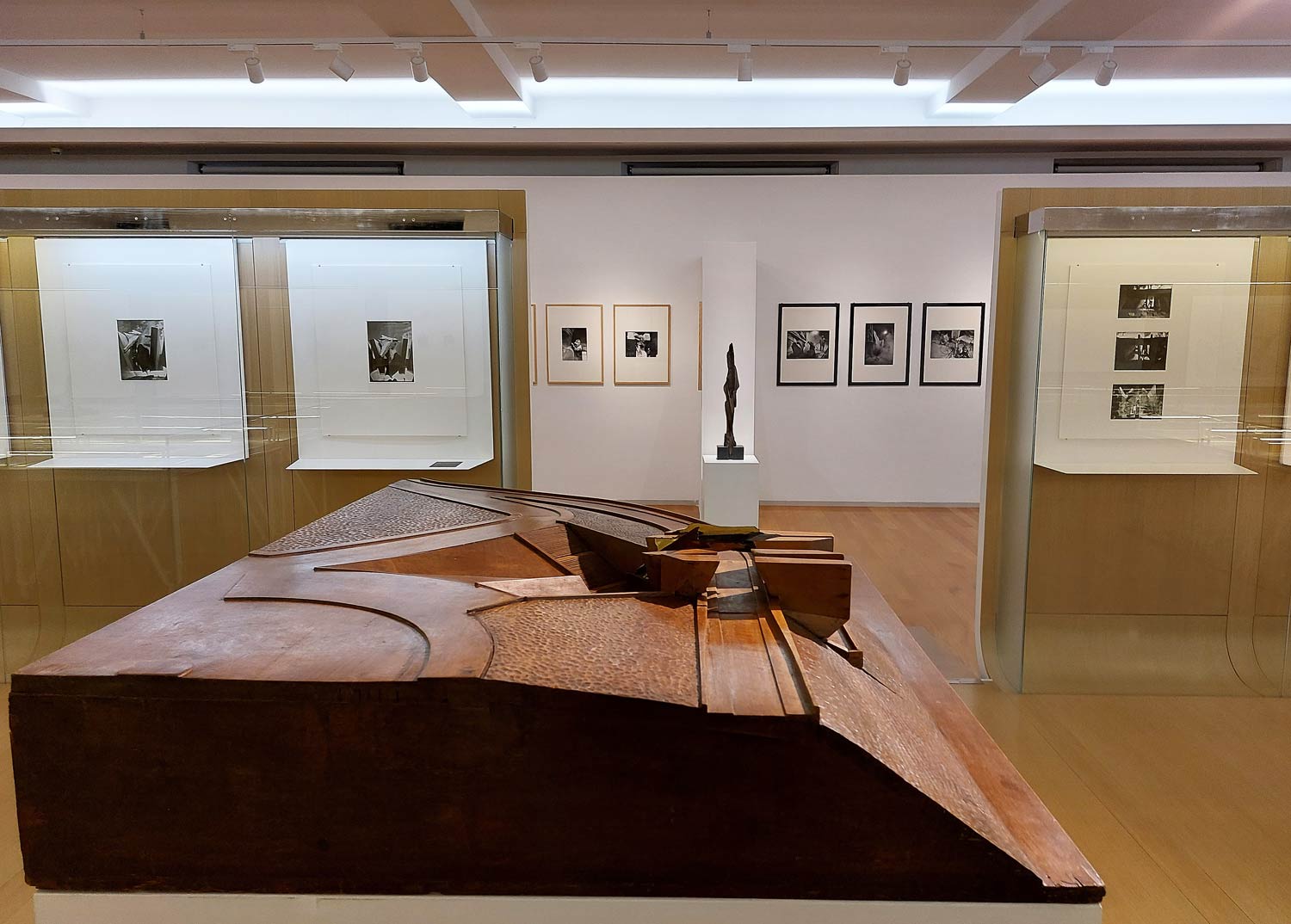
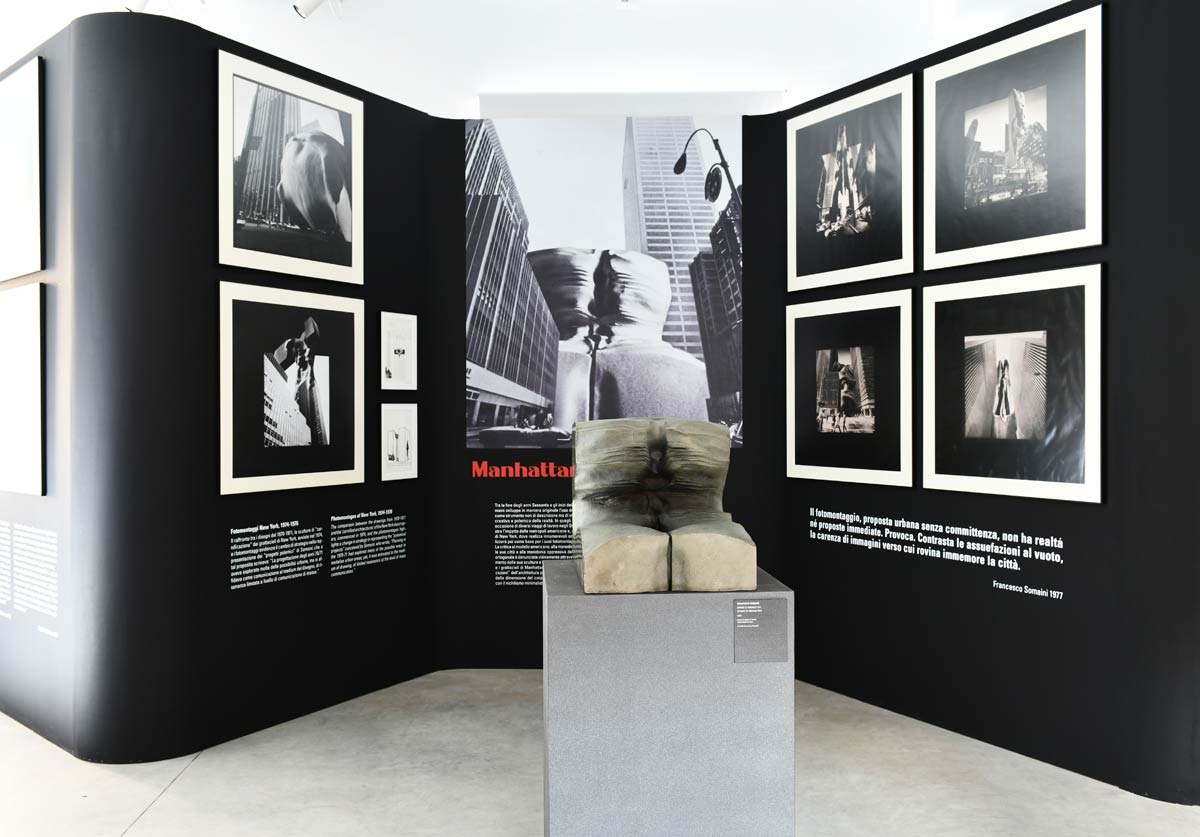

Even after Somaini had expanded the boundaries of his production abroad, the workshop in Lomazzo always remained the center of operations for all his work, going so far as to equip himself with a cabin for the use of a pressure sand jet that required him to wear a special suit and protective diving suit. The celebrated reportages by Casali, Cattaneo and Mulas restore the image of a place charged with vibrant vitality and industriousness, with periods of intense work interspersed with more intimate moments, such as the donning of the suit. The photographs are open glimpses into Somaini’s intense work sessions and his relationship with the studio, which the sculptor always experienced as a doubly sacred place: both the container of the gestation of the creative act, and a familiar refuge in which to preserve instinctive contact with art and with his own human dimension, measured in Mulas’s shots by the liquid and hermetic gazes let out by the artist’s thick armor .
Also coming out of Lomazzo’s workshop were all the international projects of recent years, now preserved in the vast Somaini Foundation Archives. Many of them are collected in the exhibition Beyond Sculpture: the City at the Foundation, curated by Luisa Somaini with Fulvio Irace, whose strong point is the strategic set-up, designed precisely to welcome the visitor right into Somaini’s work, as if to invite him or her to penetrate into the inlets of the material, in an immersive experience at once physical and mental. In the most fulfilled form of the dialogue between sculpture and architecture, Somaini’s fascination with the subway, a theme declined in various studies for subways; the photomontages of the gigantic metropolitan sculptures nestled among the buildings of New York, Düsseldorf and Duisburg, find space; the Green Thorns of the Vertical Garden (a term coined in 1972, although today it makes us think of quite different references) destined for the northern suburbs of Milan to promote the urgency of using more green-related solutions in construction, and much more.
Visionary, like most of his creations always poised between reality and utopia, is the design of the erotic/anthropomorphic garden for the Parc de La Villette competition in Paris, which is based on the rejection of the traditional format of the pleasant, polite and regular nineteenth-century garden in favor of a wilderness that is aesthetically, but also socially, more in keeping with human matter. A particular discourse is on the Lombard cities, always dear to him, Bergamo, Mantua and Como: To them Somaini devoted systematic and very detailed work sessions, giving rise to socially oriented projects that with bold and original solutions addressed the debate on issues such as irresponsible industrialization towards local communities, the disappearance and impoverishment of the suburbs and the disturbing implications of ’hyper-infrastructure at the expense of the integrity of the territory. Projects, visions, ideas as solid as architectures of the future that set the terms of a manifesto that is still consistent and more urgent than ever: “sculpture now has only the urban and social field left as a future” because “the limits of sculpture are neither technical nor poetic but social and lie in fruition.”
Warning: the translation into English of the original Italian article was created using automatic tools. We undertake to review all articles, but we do not guarantee the total absence of inaccuracies in the translation due to the program. You can find the original by clicking on the ITA button. If you find any mistake,please contact us.